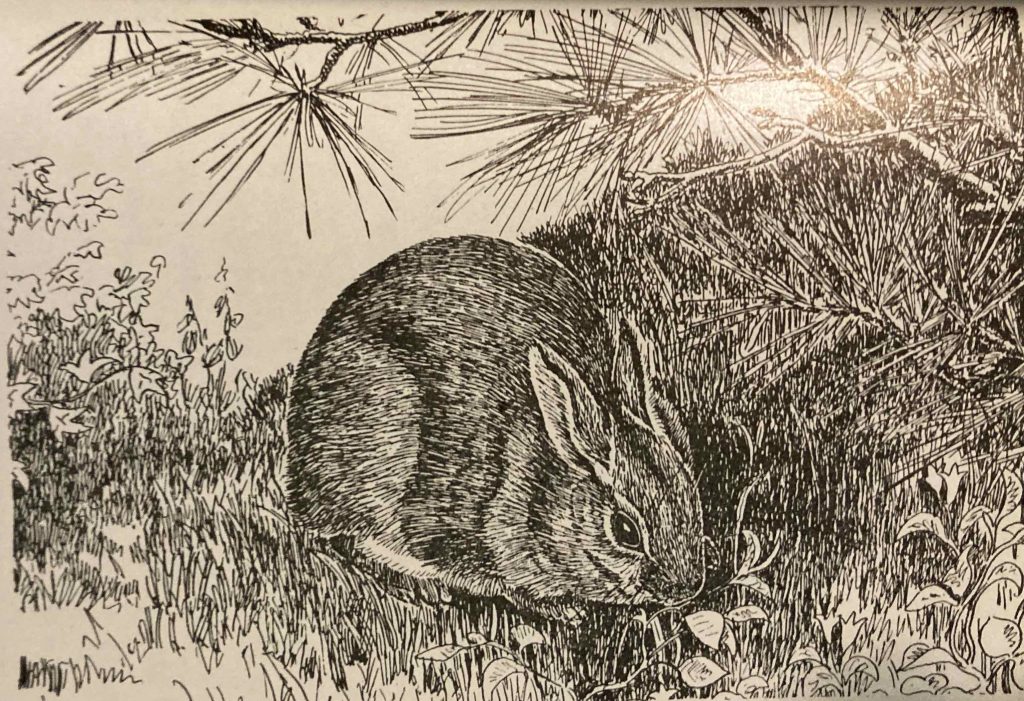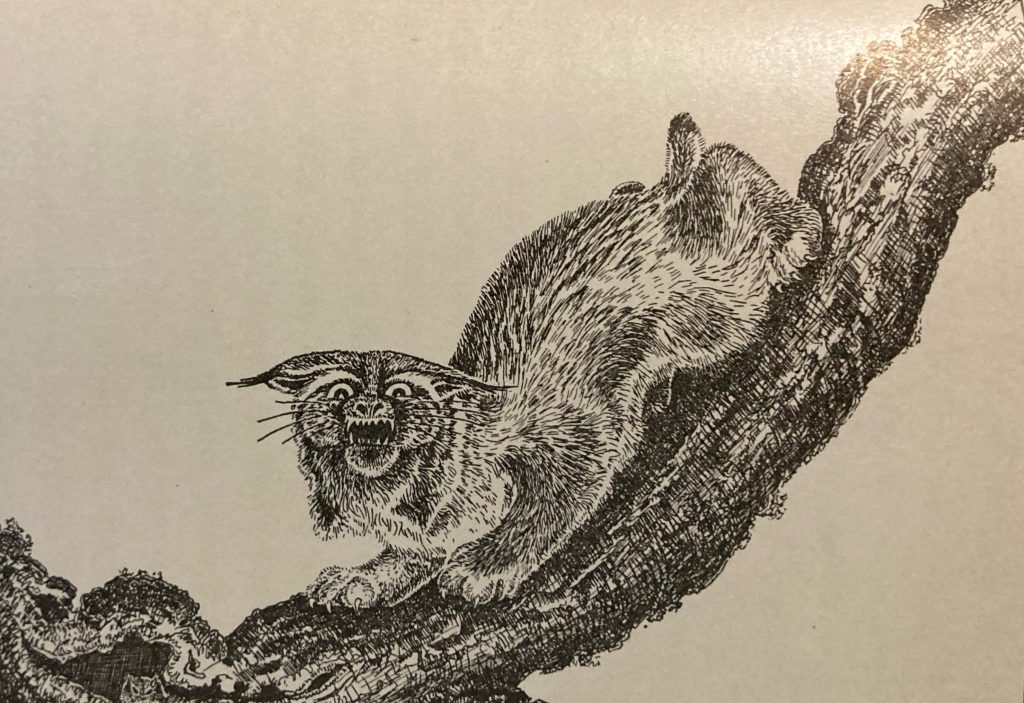

Clearly, the lynx in the drawing above is looking surprised, perhaps even shocked. Maybe this is because it was drawn in such an odd way — it almost looks like it belongs on ancient Chinese porcelain instead of a page of a nature book from a hundred years ago. Or maybe it is because it has just read the most proposterous attempt at the application of Darwinian evolutionary theory (mixed with Lamarck) imaginable. But I won’t tell you myself — I’ll let William Everett Cram share his rather deranged hypothesis, and you can make of it what you will:
Are hares and rabbits rodents or are they merely a degenerate branch of the carnivora forced by circumstances during some long forgotten period of hardship and poor hunting to adapt themselves to a vegetable diet? I have studied the question from one point of view and another until fully convinced that this is the true solution of many a vexed point concerning them. On more than one occasion I had been asked by people of more than common intelligence if I believed it possible for cats and rabbits to interbreed. My questioner in each instance felt perfectly certain that cases under observation bore sufficient proof to settle the matter beyond all ordinary doubt. Now while classed among the rodents, hares and rabbits have always been in a group by themselves. All other rodents are characterized by their incisors; two pairs of strong, chisel-like teeth for gnawing. In the hares and rabbits the under jaw is furnished in this manner, but in the upper jaw these are replaced by four small and comparatively weak teeth that resemble the front teeth of a flesh eater quite as much as they do the typical incisors of a rodent. In very young specimens there is yet another pair of even smaller teeth both in the upper and lower jaw beside the permanent ones, and it is a fact worth noting that in kittens and very young rabbits the dentition is more nearly alike than in adults. Now in pointing out the most insurmountable barrier to any possible relationship between cats and rabbits one would naturally indicate the distinguishing character of their teeth; yet while classifying animals by dentition we must not lose sight of the fact that the variation of the teeth was undoubtedly caused by the use and disuse of different teeth incident to the nature of the food the animal lived upon, and that we have no way of knowing just how long a period is required to bring about this modification. That the rodents became separated very far back in the history of animal life is a self-evident fact well borne out by sufficient testimony of fossil remains of the different ages, but let us suppose that the ancestors of our hares and rabbits were not included among the earlier rodents. Consider the possibility that at some much later period when the cat family had attained to something like its present stage of development, an island cut off from the mainland, should in the absence of native carnivora become overrun with mice, lemmings, and other small and defenceless animals; then that during a period of excessively cold winters a number of the smaller varieties of wildcats or lynxes driven southward by the cold or scarcity of food should find a way across the ice to this island, where, finding the hunting so good, they would remain until cut off from the mainland by the melting of the ice. Here they would breed and multiply until their numbers were increased to such an extent that at last the small animals that they had been living upon would be completely exterminated. Now in cases of this kind there are two courses which animals may follow according to the laws of Nature, for when the supply of food is cut off no animal will give up its hold on life without a tremendous struggle. The larger and stronger of these cats would begin to prey upon the smaller and weaker ones, while these in their turn would be under the necessity of feeding upon whatever they could get, and long before the last of the mice and insects had vanished would be tasting and nibbling at grass and berries and mushrooms, as cats, weasels and foxes will ever do in times of famine. Now the law of the survival of the fittest works unceasingly and is ever ready at just such an opening to step in and work surprising changes; use and disuse are its most potent factors; only a very small proportion of the cats on the island could possibly survive through many seasons of such privations, and these few would be the ones best able to adapt themselves to the changed conditions, viz. certain of the larger ones that proved strong and active enough to succeed in killing a sufficient number of their weaker brethren, and those among the smaller ones that managed to survive on a vegetable diet and at the same time maintain that swiftness and agility which formerly had enabled them to catch more than their share of the rapidly diminishing supply of mice and insects and “other small deer,” and must now insure their safety from being caught and eaten in their turn. The kittens of these few survivors would unquestionably have a somewhat better chance than their parents, one of Nature’s foremost laws being that the coming generation must be cherished, even at the expense of the one that went before; nourished for a time on milk (though the supply must necessarily be considerably shortened on account of the meager diet of their mothers), they would at a very early age learn to follow the example of the older ones and take to nibbling at such plants as had proved to be most nourishing to their race, in most cases quickly adapting themselves to a wholly vegetable diet. Then the law of use and disuse would step in. As generation succeeded generation of these small, grass-eating cats, the sharp two-edged canine teeth of their race (always inconspicuous in kittens) would grad- ually cease to be developed, while the incisors, which in a full-grown cat you may see as six small teeth set in a row between the projecting canines, would prove the more useful and in time would become the principal cutting or gnawing teeth, following the same law of development through need which ages before, we may suppose, built up the characteristic gnawing teeth of the true rodents. Other changes would of course be going on all the time. From constantly pushing through between the stems of bushes and thick grass (among which they would naturally find their safest hiding places) the round flat head of the cat tribe would give place to a narrow shape, which would have the added advantage of placing the eyes where they could see above and behind and on all sides at any time to forestall the possible approach of an enemy, whereas the eyes of a cat are set to focus directly in front in order better to see the quarry ahead, like those of a bird of prey. Following out along the same line we can see how the ears would grow longer to catch every faintest sound that might come down the wind, the hind legs longer for speed in running away, while the claws would lose their sharp tearing hooks through disuse; for the economy of Nature is such that only those essentials constantly in use may be long retained in perfection. Thus at the end of a few hundred thousand years (more or less) the inhabitants of our island would have evolved two separate types. Darwin says, ” Whatever the cause may be of each slight difference in the offspring from their parents (and a cause for each must exist), it is the steady accumulation, through natural selection, of such differences, when beneficial to the individual, that gives rise to all the more important modifications of structure, by which the innumerable beings on the face of the earth are enabled to struggle with each other, and the best adapted to survive.”
Alas, poor Darwin — I fear you have been most tragically and wrongfully used. But Cram doesn’t even stop there. He continues with a meticulous comparison of bone structures, offered up as evidence of his bizarre claim. Of course, Lamarck’s peculiar notion of acquired characteristics doesn’t help the situation. Finally, he offers this final tidbit, to sway any remaining disbelievers (though he does at least acknowledge its dubious scientific value):
In this connection it is to be remarked as certainly a little singular (though hardly to be accepted as scientific evidence) that the flesh of cats and rabbits is said to be so very similar in quality, that innkeepers in Europe are not infrequently convicted of substituting the one for the other without any imposition being suspected by their guests.
Tastes like chicken, perhaps? Maybe there is another evolutionary connection there that he missed!
At this point, I feel compelled to recognize my own efforts to maintain a respectful tone and genuine tolerance for scientific speculation in the nature books that I have been reading, given that most of them were written 100 years ago or more. Certainly, our understanding of prehistory has considerably advanced since 1912. However, I cannot escape the fact that this idea is completely nuts.
I find it rather amusing, in light of Cram’s own odd thinking, that he is quite willing to point out the particular failings of other mammals — remarking, for example, on “the well-known stupidity of the individual opossum”. Meanwhile, the porcupine “exhibits both in physique and character the degenerating effects of too easy living.” Cram is particularly aghast at the porcupine’s housekeeping behaviors: “For a home, the porcupine takes possession of any chance cavern among the ledges or some prostrate hollow log, apparently never making the slightest effort towards improving the condition of things as he finds them.”
For all this, late in the book, Cram weighs in on the question of whether animals act entirely out of instinct, or whether they possess intelligence sufficient to act out of reason. Ultimately, he favors reason, offering this haunting image of connecting for a moment with a member of the more-than-human world (as David Abram puts it):
There are times…when to see the thing in the doing has a convincing power greater, to the observer at least, than any conclusion arrived at by the logical balancing of evidence against evidence; when the turn of a neck, the gleam of a woodland eye looking for an instant’s glance straight into your own, leaves you with a sense of “knowing without knowing how you know” that behind the glance that met yours was a thought, and that your image reflected in the eye of the wild thing that looked at you would remain as a memory to be puzzled over.
I will leave Cram here, in this thoughtful moment of poetic reverie, lest I give in to temptations to disparage him further. Suffice it to say that sometimes publishing a sequel to a book can be a grave mistake.
That was absolutely ridiculous! Quite entertaining to read about misguided hypotheses from yesteryear.